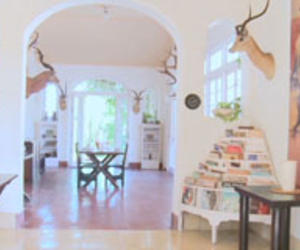Cuba? Why not?
- Submitted by: manso
- Arts and Culture
- 08 / 19 / 2011

By Linda Sosbee . Hemingway’s typewriter remains on the bookcase in his house where he stood to write his stories early every morning.
Note: This series first appeared in The Columbia Star in 2001 soon after Warner and I returned from an illegal trip to Cuba.
American novelist and short–story writer Ernest Hemingway first visited Cuba in 1928. During the 1930s he often stayed in the Hotel Ambos Mundos, room 511.
Papa frequented the neighborhood bar, La Bodeguita del Medio, near his hotel. One wall of the bar proudly displays his graffiti – mi mojito en La Bodeguita, mi daiquiri en El Floridita. These words put both places squarely on the list of the world’s great bars, drawing streams of tourists from all over the world.
Hemingway covered the Spanish Civil War for the NANA Dispatch from 1937 to 1939. After the war he returned to Havana, and in 1939 he purchased an estate called Finca La Vigia, erected in 1888, in the village of San Francisco de Paula, 15 kilometers southeast of Havana.
The only room in Hemingway’s home not containing books was the dining room. Ernest and Mary felt when you dined, you should focus on the food and the conversation, nothing else. Visiting the Finca was one of my main objectives in going to Cuba. At a travel agency in Havana, Warner made arrangements to hire a car, driver, and tour guide to take us to the home Hemingway and his wife Mary lived in for more than 20 years.
As our car turned on to the grounds of the estate, I immediately understood why the Hemingways were attracted to the property. The air was fresh and cool on this hill overlooking Havana and the ocean. The gardens were dense with mango trees, banana trees, and numerous other varieties of tropical vegetation. In the quiet calmness of the Finca, I could detect not the presence, but the essence of the man I have been fascinated with for so long.
The graves of Hemingway’s four dogs (Black, Negrita, Linda, Neron) are in the garden on his estate, Finca La Vigia, outside of Havana. The villa’s interior has remained unchanged since the day Hemingway left in 1960, as if the owner were only temporarily absent. Upon his departure, he donated the estate to the Cuban people who have preserved it as the Hemingway Museum.
Visitors are not allowed inside the house, but on days when it is not raining, the windows are flung open, and you can lean inside looking for as long as you want. Blue skies prevailed on the day of our visit, and we spent over an hour absorbing every detail of the interior – the trophy heads of wild game, the bar set squarely between two armchairs, a collection of knives and daggers, the shoe rack containing a half dozen pairs of moccasins and loafers, the typewriter where he stood to
write.
From the house, we moved on to the garden and the pool where actress Ava Gardner once swam naked. It holds no water now, but one can imagine the time when it provided exercise and relaxation for its owners.
Near the pool are the graves of four of Hemingway’s dogs: Black, Negrita, Neron, and Linda. Of course, Warner had to put my well–worn and somewhat famous traveling hat by the tombstone bearing my name.
Just beyond the graves is Papa’s fishing boat, El Pilar. It sits under a cover surrounded by a boardwalk. The boat was custom built for Hemingway in New York and provided him with one of his greatest pleasures, fishing in the Gulf Stream.
In How It Was, Mary Hemingway reports that when Earl Wilson of the New York Post wrote reporting someone considered Ernest was shirking his duties as a US citizen by living in Cuba, he replied to Earl: “I always had good luck working in Cuba. ...
I moved from Key West over here in 1938 and rented this farm and finally bought it when For Whom the Bell Tolls came out…It is a good place to work because it is out of town and on a hill so that it is cool at night. I wake up when the sun rises and go to work and when I finish I get a swim and have a drink and read the New York and Miami papers. After work you can fish or go shooting and in the evening Mary and I read and listen to music and go to bed.
“Mary loves to garden and has a good flower and vegetable garden and fine roses. ... I lost about five years work out of my life during the war, and I am trying to make up for it now. I can’t work and hang around New York because I never learned how to do it. When I hit New York it is like somebody coming off a long cattle drive hitting Dodge city in the old days.
Right now I’m driving cattle and it is a long tough drive. But this fall when The Old Man and the Sea comes out you’ll see some of the results of the last five years work.
“You find me a place in Ohio where I can live on top of a hill and be 15 minutes away from the Gulf Stream and have my own fruit and vegetables the year around and raise and fight game chickens without breaking the law and I’ll go live in Ohio if Miss Mary and my cats and dogs agree.”
After experiencing the beauty and serenity of the Finca, I understand his sentiments exactly.
Source: www.thecolumbiastar.com/news/2011-08-19/Travel/Cuba_Why_not.html
Comments